Integrating Design Thinking into Business Education
VerifiedAdded on 2020/05/16
|8
|1025
|68
AI Summary
The E-Portfolio explores the multifaceted concept of Design Thinking across different domains. In 'E- Portfolio 1', the focus is on how design-thinking principles such as empathy and prototyping can cultivate a flexible, responsive organizational culture. The reflection emphasizes that while failure should not be encouraged, it's an inherent part of iterative design processes. 'E-Portfolio 2' discusses integrating design thinking into business education to better prepare students for handling complex, real-world problems, advocating the inclusion of clinical components in educational frameworks. In 'E-Portfolio 3', the role of digital fabrication in enhancing student learning is analyzed, showing mixed understanding among students regarding its complexities. The fourth portfolio examines Kaiser Permanente's ten-year use of design thinking to innovate and improve managerial processes, highlighting overlapping areas with improvement science. Lastly, 'E-Portfolio 5' argues for a shift in design practices towards fostering a Circular Economy, emphasizing the critical role designers play in meeting contemporary economic and environmental challenges.
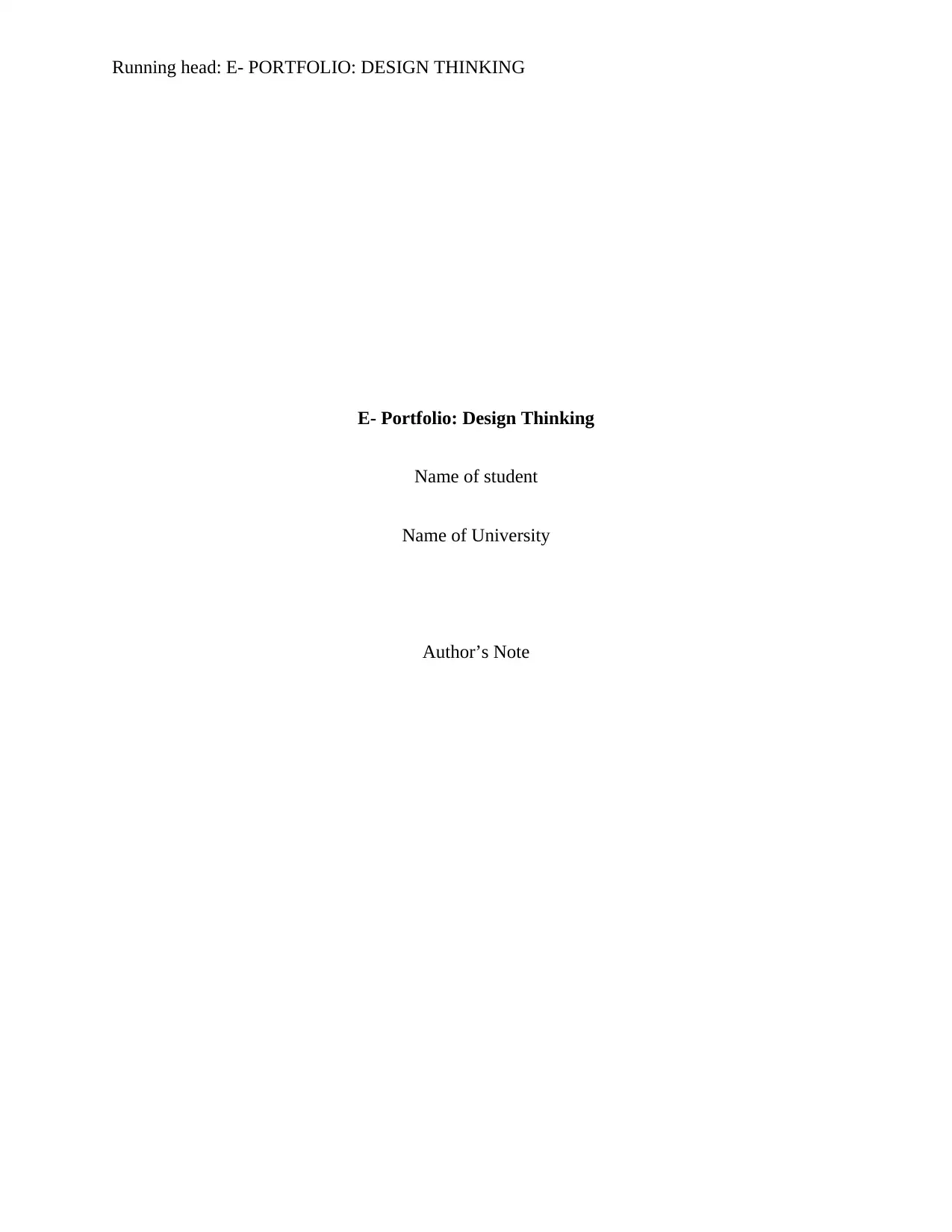
Running head: E- PORTFOLIO: DESIGN THINKING
E- Portfolio: Design Thinking
Name of student
Name of University
Author’s Note
E- Portfolio: Design Thinking
Name of student
Name of University
Author’s Note
Paraphrase This Document
Need a fresh take? Get an instant paraphrase of this document with our AI Paraphraser
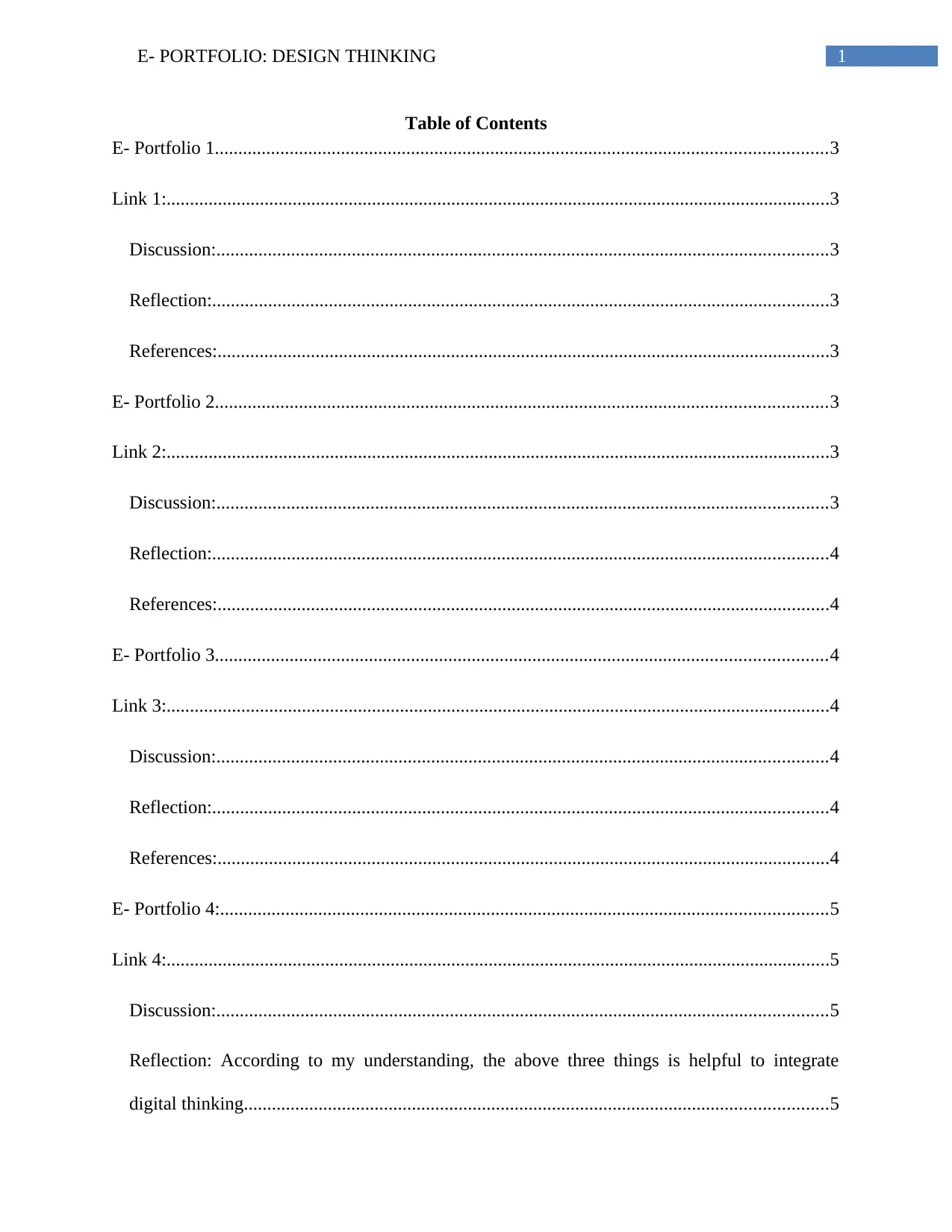
1E- PORTFOLIO: DESIGN THINKING
Table of Contents
E- Portfolio 1...................................................................................................................................3
Link 1:..............................................................................................................................................3
Discussion:...................................................................................................................................3
Reflection:....................................................................................................................................3
References:...................................................................................................................................3
E- Portfolio 2...................................................................................................................................3
Link 2:..............................................................................................................................................3
Discussion:...................................................................................................................................3
Reflection:....................................................................................................................................4
References:...................................................................................................................................4
E- Portfolio 3...................................................................................................................................4
Link 3:..............................................................................................................................................4
Discussion:...................................................................................................................................4
Reflection:....................................................................................................................................4
References:...................................................................................................................................4
E- Portfolio 4:..................................................................................................................................5
Link 4:..............................................................................................................................................5
Discussion:...................................................................................................................................5
Reflection: According to my understanding, the above three things is helpful to integrate
digital thinking.............................................................................................................................5
Table of Contents
E- Portfolio 1...................................................................................................................................3
Link 1:..............................................................................................................................................3
Discussion:...................................................................................................................................3
Reflection:....................................................................................................................................3
References:...................................................................................................................................3
E- Portfolio 2...................................................................................................................................3
Link 2:..............................................................................................................................................3
Discussion:...................................................................................................................................3
Reflection:....................................................................................................................................4
References:...................................................................................................................................4
E- Portfolio 3...................................................................................................................................4
Link 3:..............................................................................................................................................4
Discussion:...................................................................................................................................4
Reflection:....................................................................................................................................4
References:...................................................................................................................................4
E- Portfolio 4:..................................................................................................................................5
Link 4:..............................................................................................................................................5
Discussion:...................................................................................................................................5
Reflection: According to my understanding, the above three things is helpful to integrate
digital thinking.............................................................................................................................5
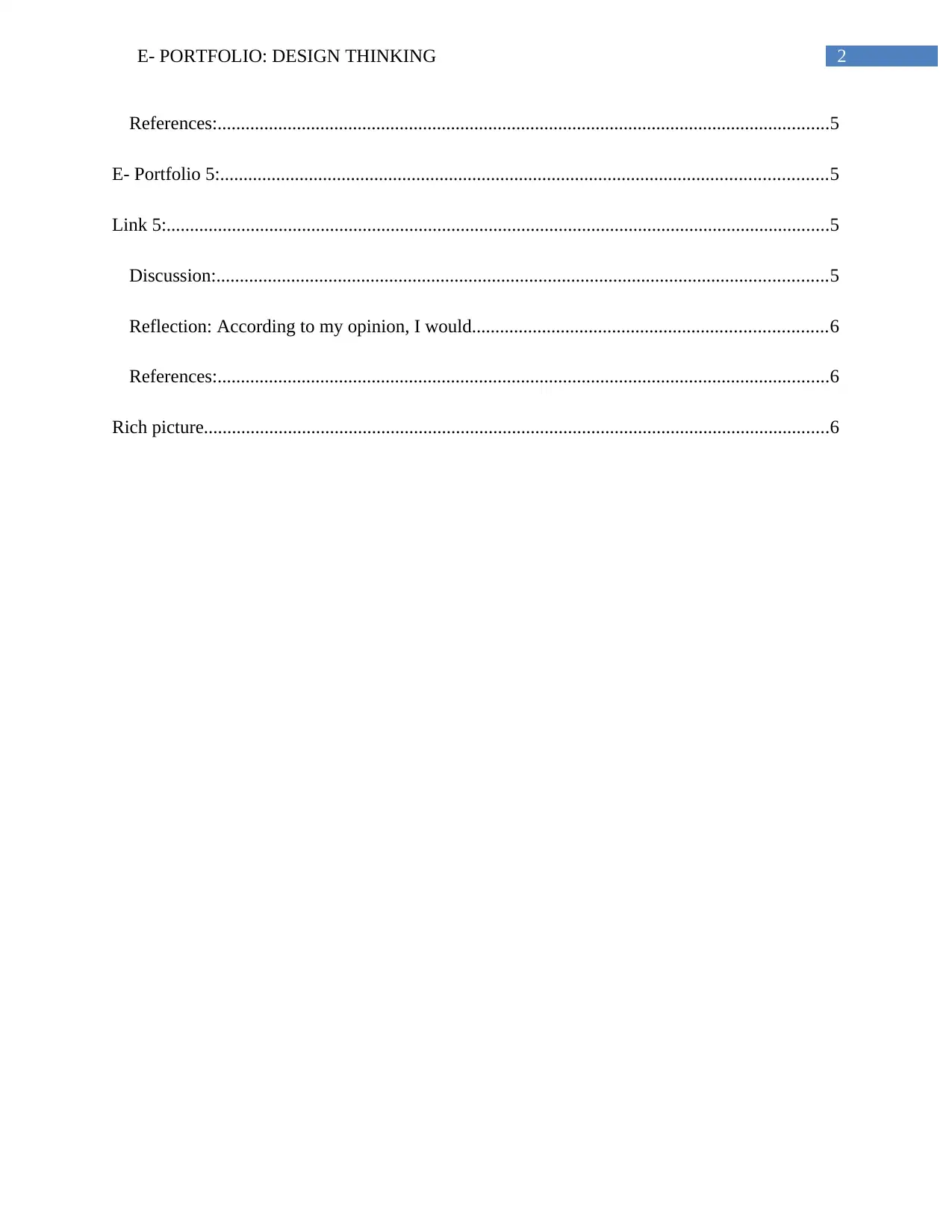
2E- PORTFOLIO: DESIGN THINKING
References:...................................................................................................................................5
E- Portfolio 5:..................................................................................................................................5
Link 5:..............................................................................................................................................5
Discussion:...................................................................................................................................5
Reflection: According to my opinion, I would............................................................................6
References:...................................................................................................................................6
Rich picture......................................................................................................................................6
References:...................................................................................................................................5
E- Portfolio 5:..................................................................................................................................5
Link 5:..............................................................................................................................................5
Discussion:...................................................................................................................................5
Reflection: According to my opinion, I would............................................................................6
References:...................................................................................................................................6
Rich picture......................................................................................................................................6
⊘ This is a preview!⊘
Do you want full access?
Subscribe today to unlock all pages.

Trusted by 1+ million students worldwide
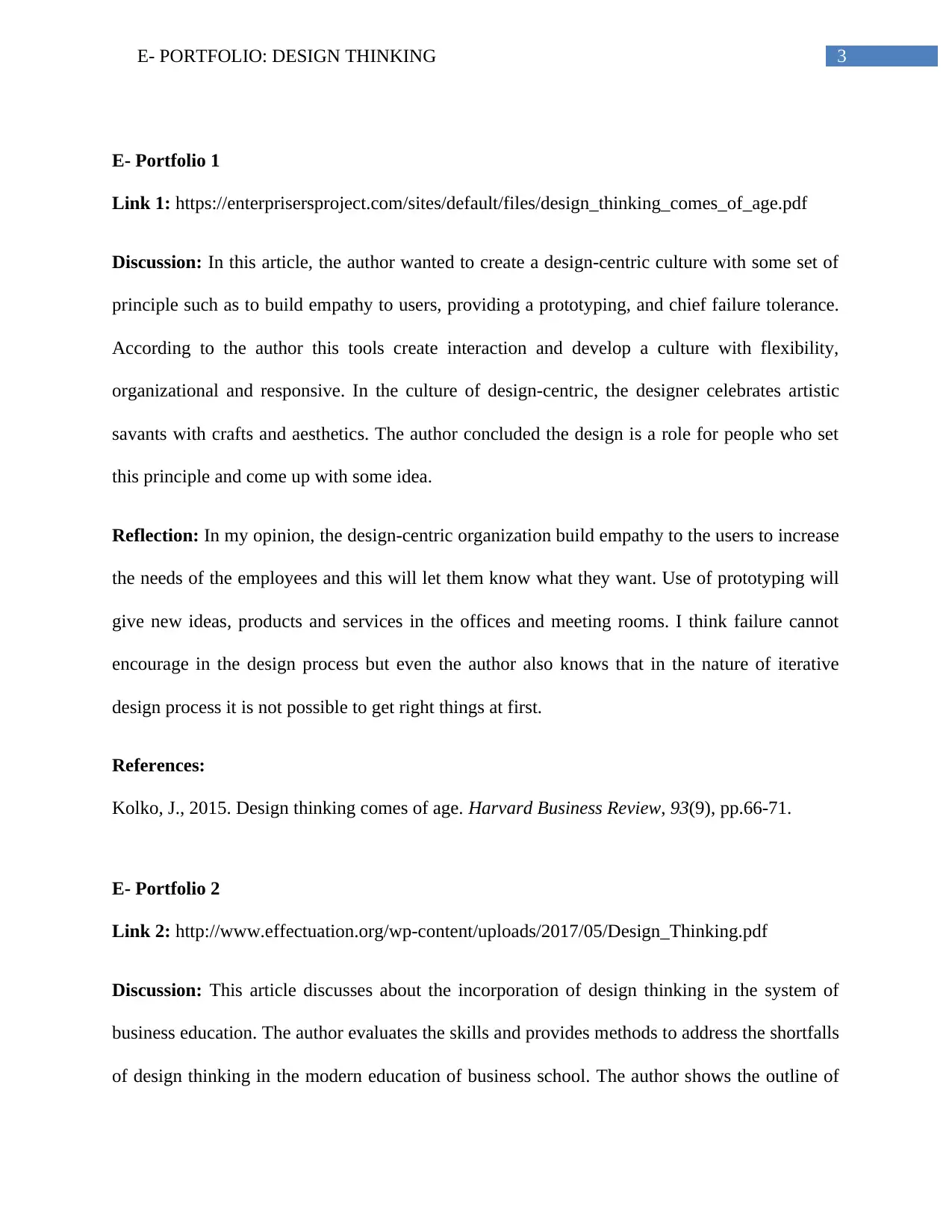
3E- PORTFOLIO: DESIGN THINKING
E- Portfolio 1
Link 1: https://enterprisersproject.com/sites/default/files/design_thinking_comes_of_age.pdf
Discussion: In this article, the author wanted to create a design-centric culture with some set of
principle such as to build empathy to users, providing a prototyping, and chief failure tolerance.
According to the author this tools create interaction and develop a culture with flexibility,
organizational and responsive. In the culture of design-centric, the designer celebrates artistic
savants with crafts and aesthetics. The author concluded the design is a role for people who set
this principle and come up with some idea.
Reflection: In my opinion, the design-centric organization build empathy to the users to increase
the needs of the employees and this will let them know what they want. Use of prototyping will
give new ideas, products and services in the offices and meeting rooms. I think failure cannot
encourage in the design process but even the author also knows that in the nature of iterative
design process it is not possible to get right things at first.
References:
Kolko, J., 2015. Design thinking comes of age. Harvard Business Review, 93(9), pp.66-71.
E- Portfolio 2
Link 2: http://www.effectuation.org/wp-content/uploads/2017/05/Design_Thinking.pdf
Discussion: This article discusses about the incorporation of design thinking in the system of
business education. The author evaluates the skills and provides methods to address the shortfalls
of design thinking in the modern education of business school. The author shows the outline of
E- Portfolio 1
Link 1: https://enterprisersproject.com/sites/default/files/design_thinking_comes_of_age.pdf
Discussion: In this article, the author wanted to create a design-centric culture with some set of
principle such as to build empathy to users, providing a prototyping, and chief failure tolerance.
According to the author this tools create interaction and develop a culture with flexibility,
organizational and responsive. In the culture of design-centric, the designer celebrates artistic
savants with crafts and aesthetics. The author concluded the design is a role for people who set
this principle and come up with some idea.
Reflection: In my opinion, the design-centric organization build empathy to the users to increase
the needs of the employees and this will let them know what they want. Use of prototyping will
give new ideas, products and services in the offices and meeting rooms. I think failure cannot
encourage in the design process but even the author also knows that in the nature of iterative
design process it is not possible to get right things at first.
References:
Kolko, J., 2015. Design thinking comes of age. Harvard Business Review, 93(9), pp.66-71.
E- Portfolio 2
Link 2: http://www.effectuation.org/wp-content/uploads/2017/05/Design_Thinking.pdf
Discussion: This article discusses about the incorporation of design thinking in the system of
business education. The author evaluates the skills and provides methods to address the shortfalls
of design thinking in the modern education of business school. The author shows the outline of
Paraphrase This Document
Need a fresh take? Get an instant paraphrase of this document with our AI Paraphraser
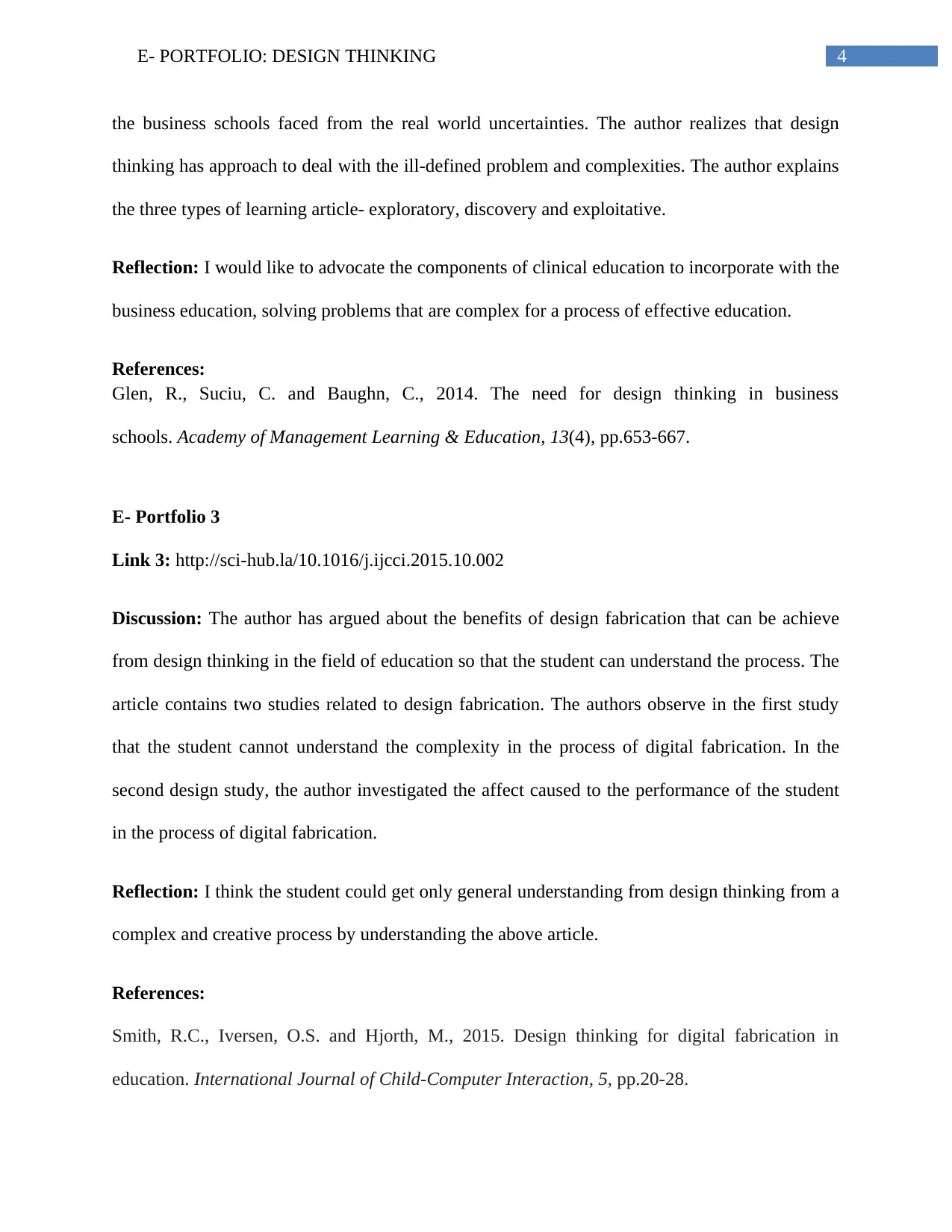
4E- PORTFOLIO: DESIGN THINKING
the business schools faced from the real world uncertainties. The author realizes that design
thinking has approach to deal with the ill-defined problem and complexities. The author explains
the three types of learning article- exploratory, discovery and exploitative.
Reflection: I would like to advocate the components of clinical education to incorporate with the
business education, solving problems that are complex for a process of effective education.
References:
Glen, R., Suciu, C. and Baughn, C., 2014. The need for design thinking in business
schools. Academy of Management Learning & Education, 13(4), pp.653-667.
E- Portfolio 3
Link 3: http://sci-hub.la/10.1016/j.ijcci.2015.10.002
Discussion: The author has argued about the benefits of design fabrication that can be achieve
from design thinking in the field of education so that the student can understand the process. The
article contains two studies related to design fabrication. The authors observe in the first study
that the student cannot understand the complexity in the process of digital fabrication. In the
second design study, the author investigated the affect caused to the performance of the student
in the process of digital fabrication.
Reflection: I think the student could get only general understanding from design thinking from a
complex and creative process by understanding the above article.
References:
Smith, R.C., Iversen, O.S. and Hjorth, M., 2015. Design thinking for digital fabrication in
education. International Journal of Child-Computer Interaction, 5, pp.20-28.
the business schools faced from the real world uncertainties. The author realizes that design
thinking has approach to deal with the ill-defined problem and complexities. The author explains
the three types of learning article- exploratory, discovery and exploitative.
Reflection: I would like to advocate the components of clinical education to incorporate with the
business education, solving problems that are complex for a process of effective education.
References:
Glen, R., Suciu, C. and Baughn, C., 2014. The need for design thinking in business
schools. Academy of Management Learning & Education, 13(4), pp.653-667.
E- Portfolio 3
Link 3: http://sci-hub.la/10.1016/j.ijcci.2015.10.002
Discussion: The author has argued about the benefits of design fabrication that can be achieve
from design thinking in the field of education so that the student can understand the process. The
article contains two studies related to design fabrication. The authors observe in the first study
that the student cannot understand the complexity in the process of digital fabrication. In the
second design study, the author investigated the affect caused to the performance of the student
in the process of digital fabrication.
Reflection: I think the student could get only general understanding from design thinking from a
complex and creative process by understanding the above article.
References:
Smith, R.C., Iversen, O.S. and Hjorth, M., 2015. Design thinking for digital fabrication in
education. International Journal of Child-Computer Interaction, 5, pp.20-28.
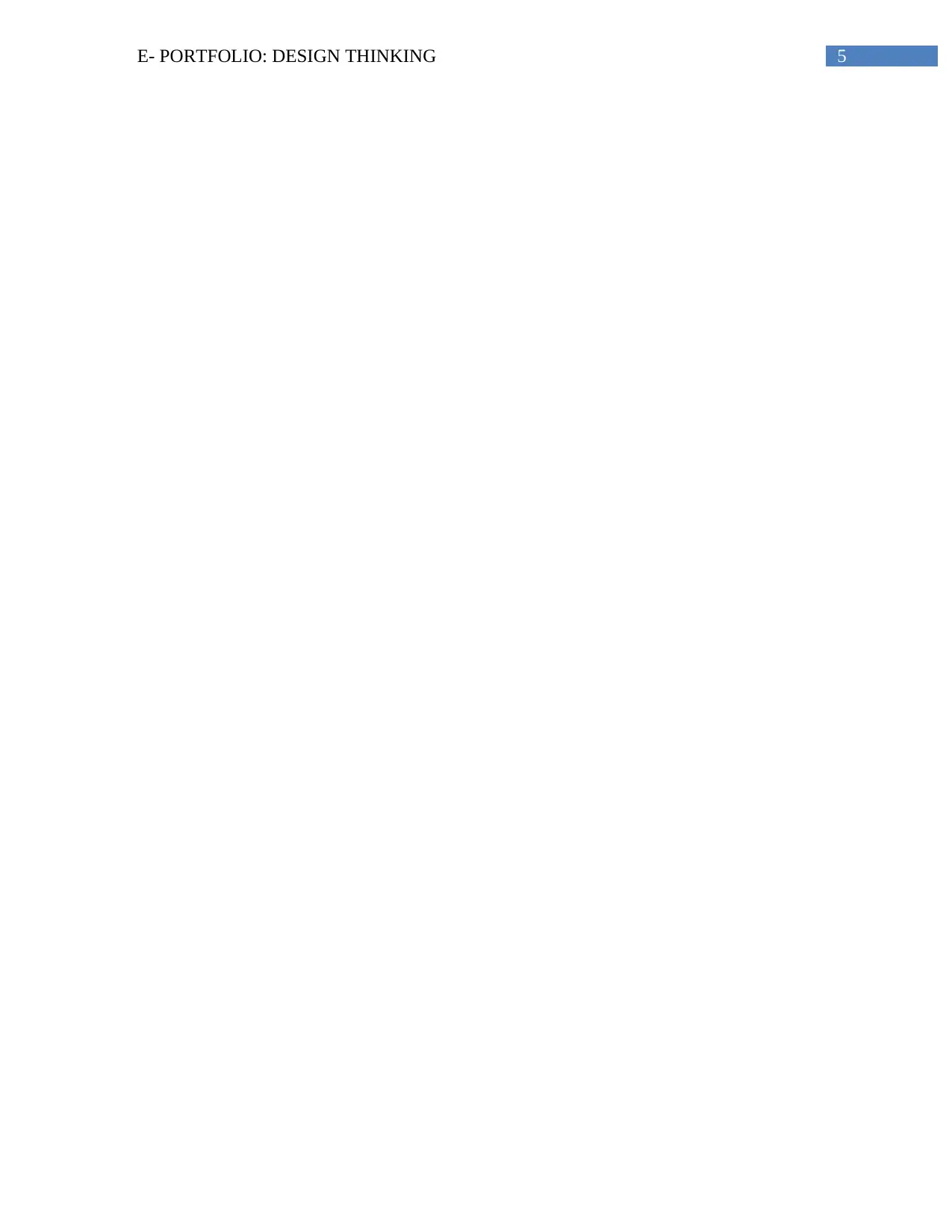
5E- PORTFOLIO: DESIGN THINKING
⊘ This is a preview!⊘
Do you want full access?
Subscribe today to unlock all pages.

Trusted by 1+ million students worldwide
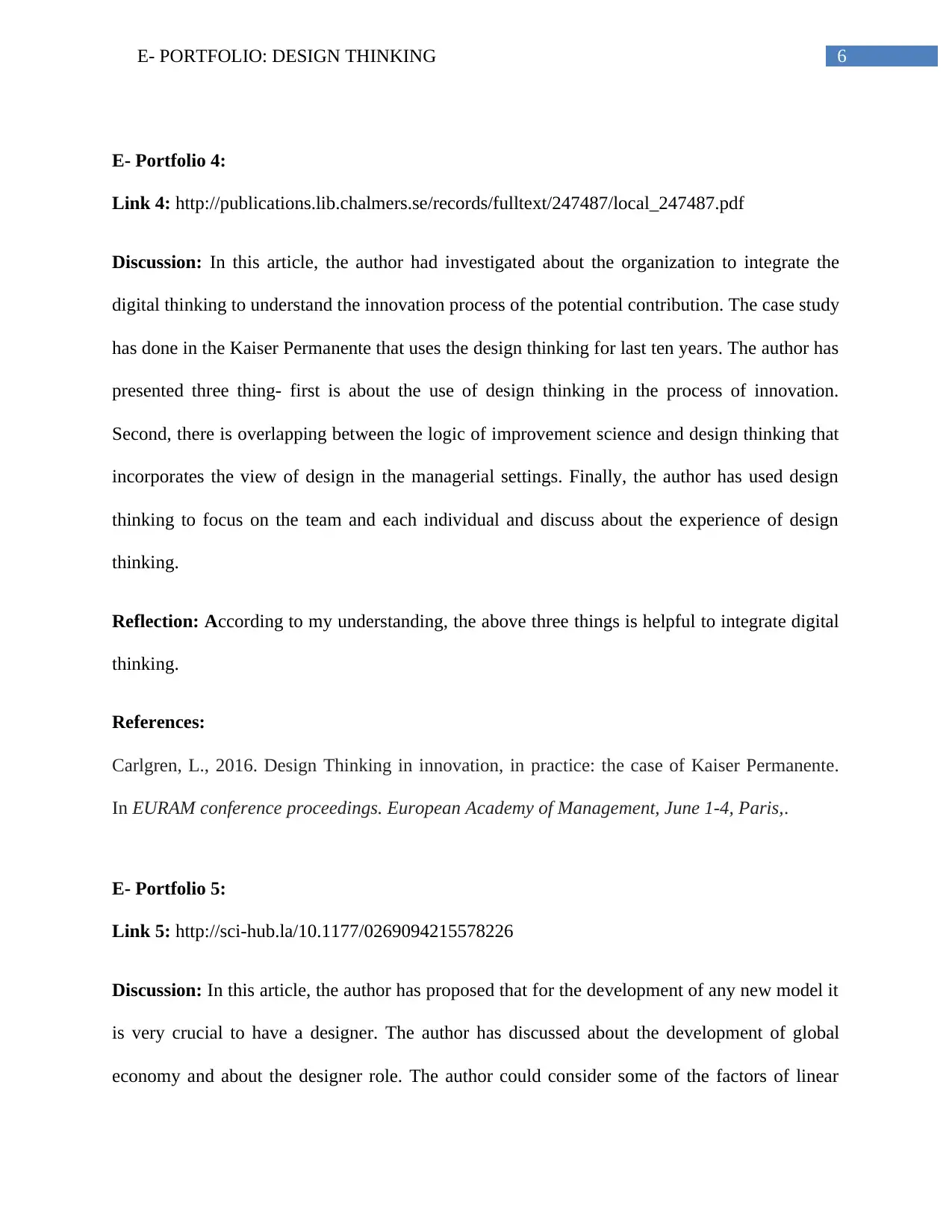
6E- PORTFOLIO: DESIGN THINKING
E- Portfolio 4:
Link 4: http://publications.lib.chalmers.se/records/fulltext/247487/local_247487.pdf
Discussion: In this article, the author had investigated about the organization to integrate the
digital thinking to understand the innovation process of the potential contribution. The case study
has done in the Kaiser Permanente that uses the design thinking for last ten years. The author has
presented three thing- first is about the use of design thinking in the process of innovation.
Second, there is overlapping between the logic of improvement science and design thinking that
incorporates the view of design in the managerial settings. Finally, the author has used design
thinking to focus on the team and each individual and discuss about the experience of design
thinking.
Reflection: According to my understanding, the above three things is helpful to integrate digital
thinking.
References:
Carlgren, L., 2016. Design Thinking in innovation, in practice: the case of Kaiser Permanente.
In EURAM conference proceedings. European Academy of Management, June 1-4, Paris,.
E- Portfolio 5:
Link 5: http://sci-hub.la/10.1177/0269094215578226
Discussion: In this article, the author has proposed that for the development of any new model it
is very crucial to have a designer. The author has discussed about the development of global
economy and about the designer role. The author could consider some of the factors of linear
E- Portfolio 4:
Link 4: http://publications.lib.chalmers.se/records/fulltext/247487/local_247487.pdf
Discussion: In this article, the author had investigated about the organization to integrate the
digital thinking to understand the innovation process of the potential contribution. The case study
has done in the Kaiser Permanente that uses the design thinking for last ten years. The author has
presented three thing- first is about the use of design thinking in the process of innovation.
Second, there is overlapping between the logic of improvement science and design thinking that
incorporates the view of design in the managerial settings. Finally, the author has used design
thinking to focus on the team and each individual and discuss about the experience of design
thinking.
Reflection: According to my understanding, the above three things is helpful to integrate digital
thinking.
References:
Carlgren, L., 2016. Design Thinking in innovation, in practice: the case of Kaiser Permanente.
In EURAM conference proceedings. European Academy of Management, June 1-4, Paris,.
E- Portfolio 5:
Link 5: http://sci-hub.la/10.1177/0269094215578226
Discussion: In this article, the author has proposed that for the development of any new model it
is very crucial to have a designer. The author has discussed about the development of global
economy and about the designer role. The author could consider some of the factors of linear
Paraphrase This Document
Need a fresh take? Get an instant paraphrase of this document with our AI Paraphraser
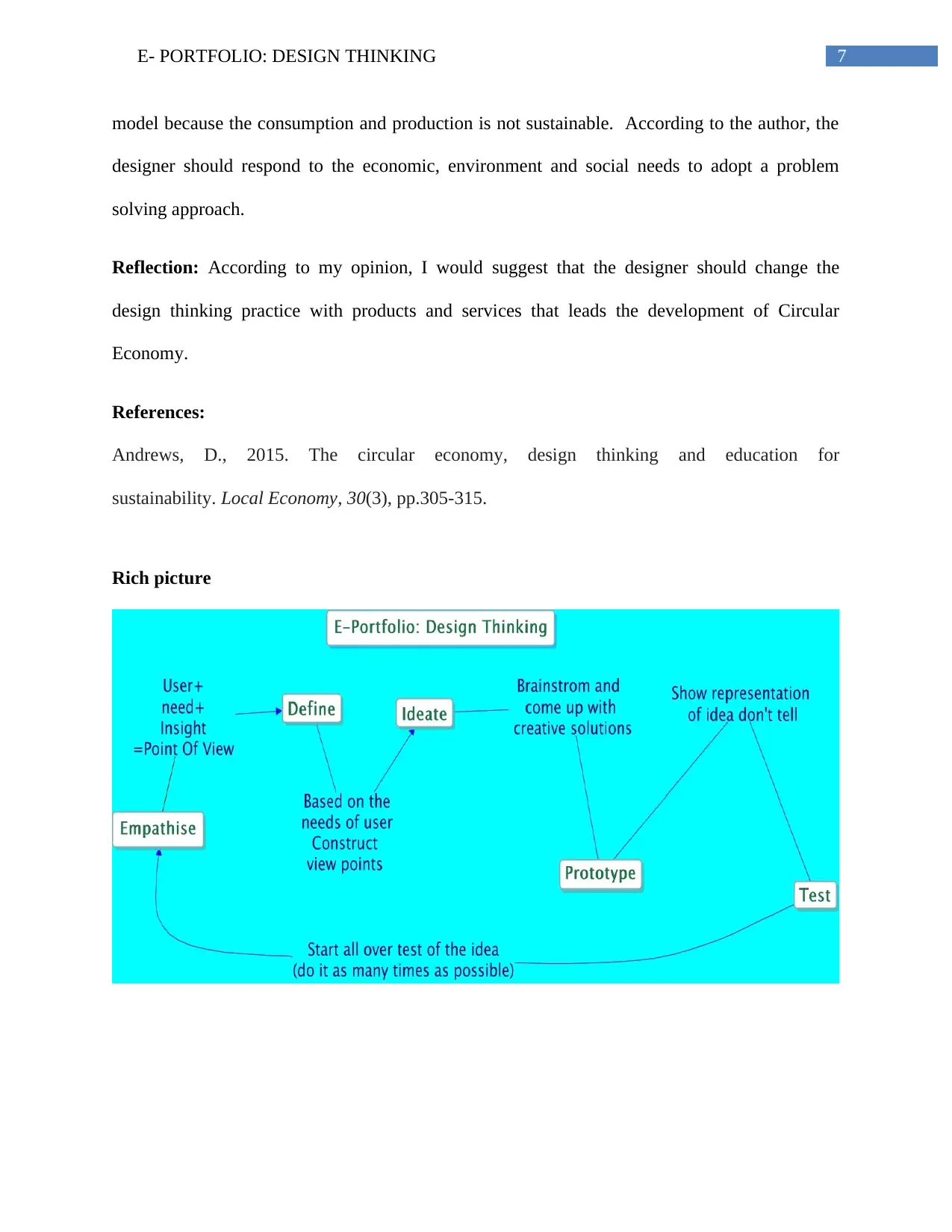
7E- PORTFOLIO: DESIGN THINKING
model because the consumption and production is not sustainable. According to the author, the
designer should respond to the economic, environment and social needs to adopt a problem
solving approach.
Reflection: According to my opinion, I would suggest that the designer should change the
design thinking practice with products and services that leads the development of Circular
Economy.
References:
Andrews, D., 2015. The circular economy, design thinking and education for
sustainability. Local Economy, 30(3), pp.305-315.
Rich picture
model because the consumption and production is not sustainable. According to the author, the
designer should respond to the economic, environment and social needs to adopt a problem
solving approach.
Reflection: According to my opinion, I would suggest that the designer should change the
design thinking practice with products and services that leads the development of Circular
Economy.
References:
Andrews, D., 2015. The circular economy, design thinking and education for
sustainability. Local Economy, 30(3), pp.305-315.
Rich picture
1 out of 8
Related Documents
Your All-in-One AI-Powered Toolkit for Academic Success.
+13062052269
info@desklib.com
Available 24*7 on WhatsApp / Email
![[object Object]](/_next/static/media/star-bottom.7253800d.svg)
Unlock your academic potential
Copyright © 2020–2025 A2Z Services. All Rights Reserved. Developed and managed by ZUCOL.




